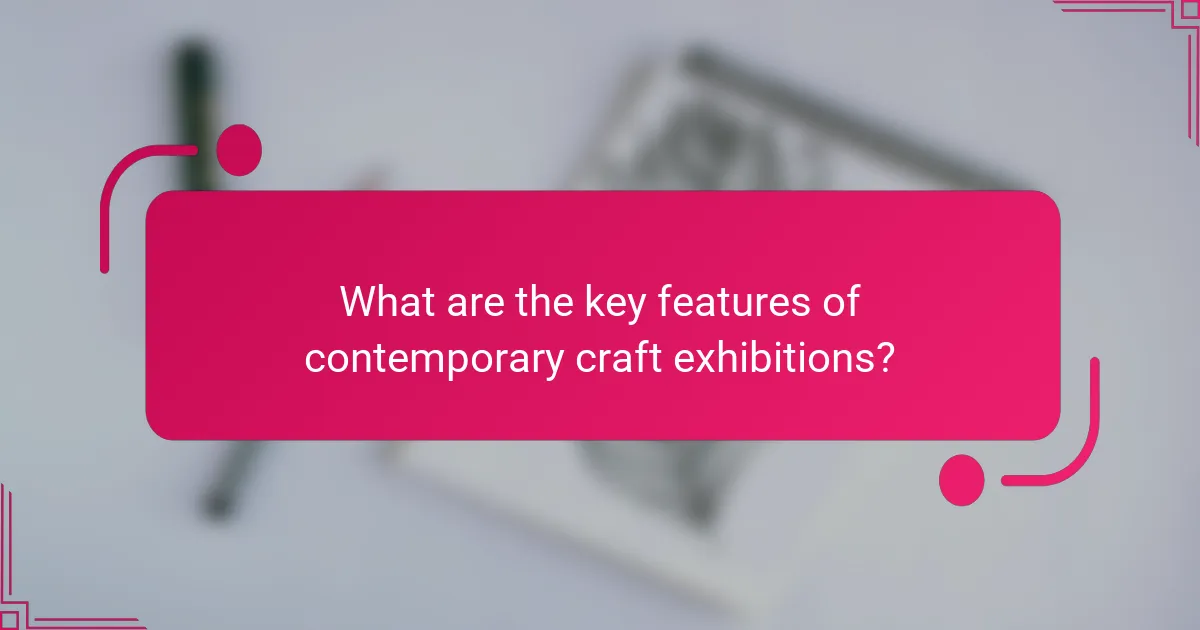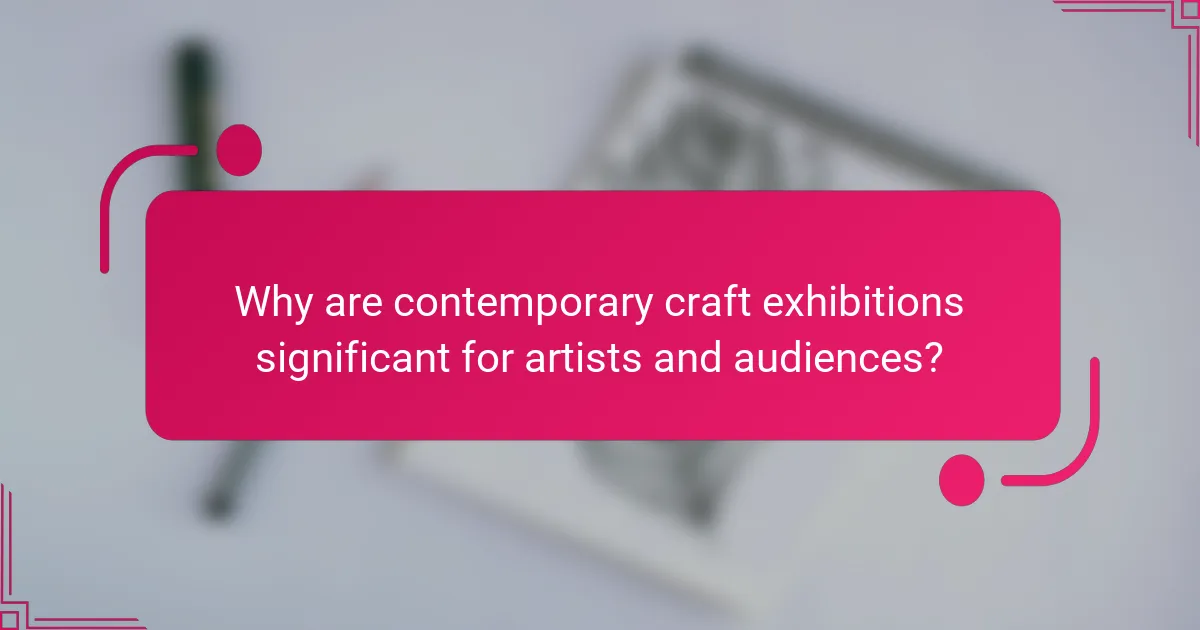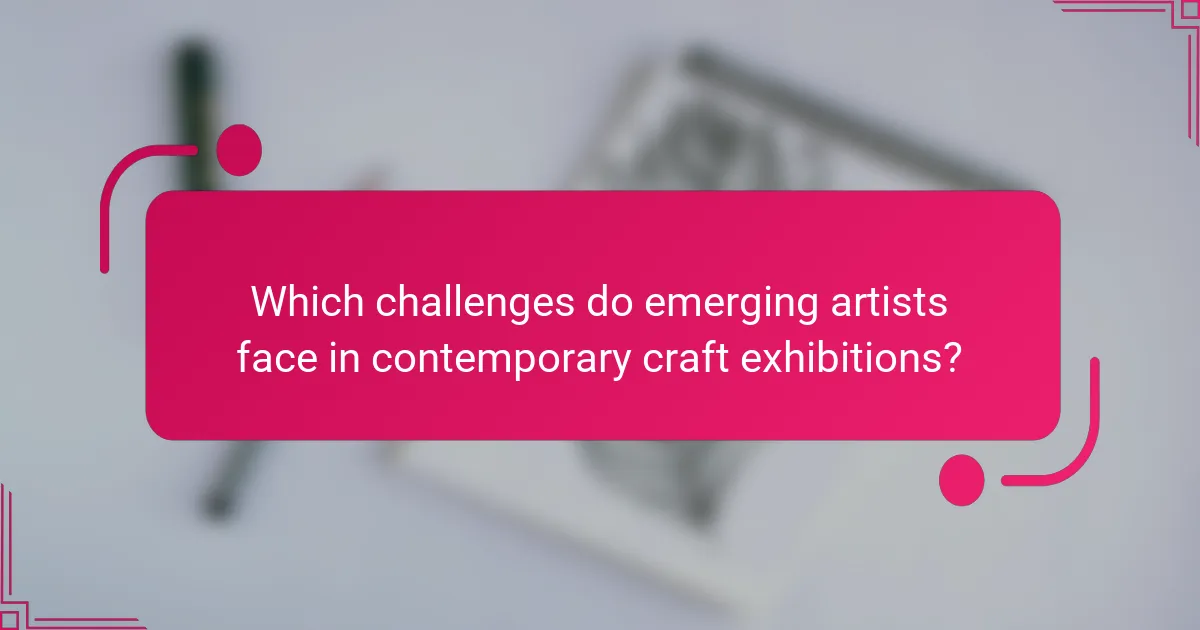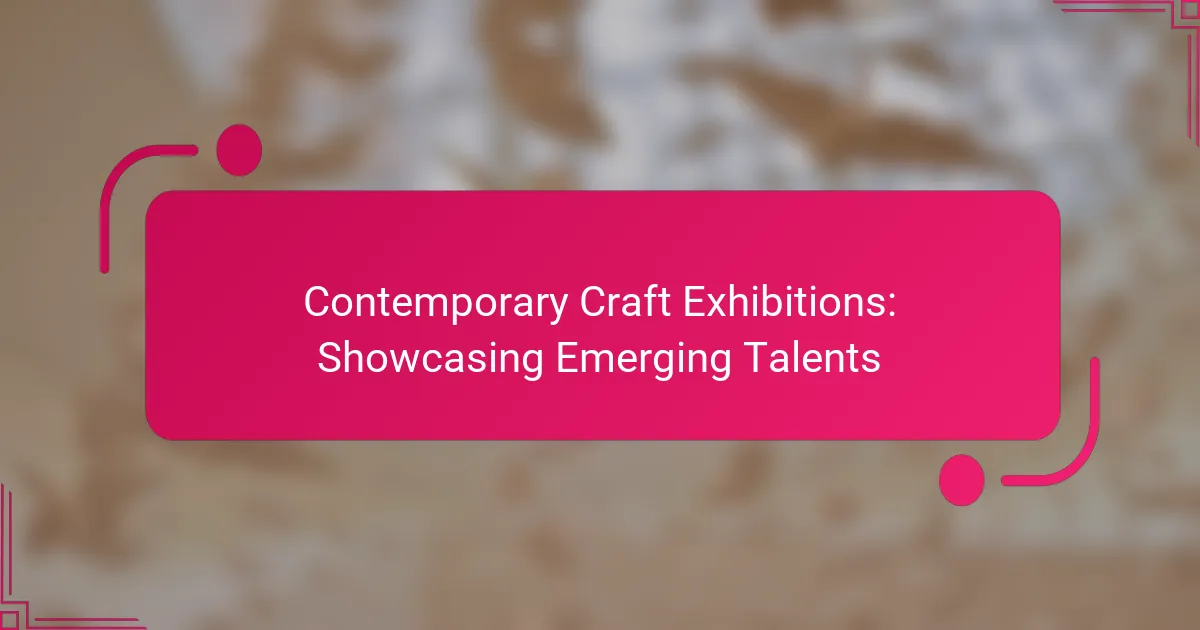Contemporary craft exhibitions play a crucial role in connecting emerging talents with audiences. They highlight diverse mediums, foster community engagement, and emphasize sustainability. Regional variations shape the artistic narratives presented, while challenges like limited visibility and financial constraints affect artists. Successful curation involves selecting high-quality works, defining resonant themes, and incorporating interactive elements.

What are the key features of contemporary craft exhibitions?
Contemporary craft exhibitions showcase emerging talents through diverse mediums and innovative techniques. Key features include interactive displays, curated themes, and a focus on sustainability. These exhibitions often highlight collaboration between artists and communities, fostering engagement and dialogue. Additionally, they provide platforms for underrepresented voices, enhancing the cultural narrative.
How do contemporary craft exhibitions support emerging talents?
Contemporary craft exhibitions play a vital role in supporting emerging talents by providing them with visibility and networking opportunities. These exhibitions showcase innovative works and facilitate connections between artists and industry professionals.
Emerging talents benefit from exposure to diverse audiences, which can lead to potential sales and collaborations. Additionally, the curated nature of these exhibitions often highlights unique attributes of the artists, such as their distinctive styles or cultural backgrounds.
Support from established artists and mentors at these events can enhance the growth and development of newcomers. As a result, contemporary craft exhibitions serve as essential platforms for nurturing the next generation of creative talent.
Which mediums are most commonly showcased in these exhibitions?
Contemporary craft exhibitions commonly showcase mediums such as ceramics, textiles, glass, wood, metal, and mixed media. These mediums highlight the versatility and creativity of emerging talents in the craft sector. Ceramics often feature innovative glazing techniques, while textiles may include contemporary weaving and embroidery. Glass art frequently showcases both functional and sculptural forms, and wood and metal crafts emphasize traditional craftsmanship combined with modern aesthetics. Mixed media works provide a unique platform for artists to explore interdisciplinary approaches.
What role do local communities play in contemporary craft exhibitions?
Local communities play a crucial role in contemporary craft exhibitions by fostering engagement and support for emerging talents. They provide a platform for local artisans to showcase their work, creating a sense of pride and ownership. Community involvement enhances the authenticity of exhibitions, attracting visitors who seek unique, locally made crafts. Additionally, local organizations often collaborate to promote these events, increasing visibility and participation. This symbiotic relationship strengthens both the craft scene and community bonds, illustrating the importance of grassroots support in the arts.

How do contemporary craft exhibitions differ across regions?
Contemporary craft exhibitions vary significantly across regions due to cultural influences, artistic trends, and local resources. In Europe, exhibitions often emphasize traditional techniques blended with modern aesthetics, showcasing artisans who maintain heritage while innovating. In contrast, North American exhibitions frequently highlight diverse materials and experimental approaches, reflecting a more eclectic artistic environment. Asian exhibitions may focus on craftsmanship and spirituality, integrating traditional practices with contemporary themes. The unique attributes of each region shape the narratives and experiences presented, creating distinct atmospheres that celebrate local talent and craft.
What unique attributes define exhibitions in North America?
Unique attributes defining contemporary craft exhibitions in North America include a focus on innovative materials, interactive installations, and diverse cultural representations. Emerging talents often showcase personal narratives through their work, creating a deeper connection with audiences. These exhibitions frequently incorporate sustainability practices, reflecting contemporary values in craftsmanship. Additionally, they provide networking opportunities for artists and curators, fostering collaboration within the craft community.
How do cultural influences shape craft exhibitions in Europe?
Cultural influences significantly shape craft exhibitions in Europe by highlighting regional traditions and contemporary practices. These exhibitions often reflect local heritage, showcasing unique craftsmanship and techniques. For example, the integration of sustainable materials in crafts responds to growing environmental awareness. Additionally, collaborations between artists from diverse backgrounds foster innovation and cultural exchange. As a result, these exhibitions serve as platforms for emerging talents, blending tradition with modernity to engage a wider audience.
Which trends are emerging in contemporary craft exhibitions globally?
Emerging trends in contemporary craft exhibitions include a focus on sustainability, digital integration, and community engagement. These exhibitions increasingly showcase diverse cultural narratives and innovative techniques.
Sustainability is a core theme, with artists using eco-friendly materials and practices. Digital integration allows for virtual exhibitions and interactive installations, expanding audience reach. Community engagement fosters collaboration, with local artists participating in workshops and events.
These trends reflect a shift towards inclusivity and environmental consciousness, shaping the future of contemporary craft exhibitions globally.

Why are contemporary craft exhibitions significant for artists and audiences?
Contemporary craft exhibitions are significant as they provide a platform for emerging talents to connect with audiences. These exhibitions foster creativity and innovation, showcasing unique artistic expressions. They also promote dialogue between artists and viewers, enhancing appreciation for craftsmanship. Additionally, they help in building professional networks, which can lead to future opportunities for artists.
What opportunities do these exhibitions provide for networking?
Contemporary craft exhibitions provide significant networking opportunities for artists and professionals. Participants can connect with industry leaders, potential collaborators, and art enthusiasts. These events foster relationships that can lead to mentorship, partnerships, and exposure to new markets. Additionally, engaging discussions and workshops enhance learning and collaboration among emerging talents.
How do they facilitate the exchange of ideas among artists?
Contemporary craft exhibitions facilitate the exchange of ideas among artists through networking opportunities, collaborative projects, and interactive workshops. These events create a platform for emerging talents to showcase their work and engage in dialogue with peers. By fostering an environment of creativity and innovation, artists can share techniques and insights, enhancing their artistic development. Additionally, exhibitions often include panel discussions and artist talks, allowing for deeper exploration of artistic concepts and trends.
What impact do contemporary craft exhibitions have on public engagement with art?
Contemporary craft exhibitions significantly enhance public engagement with art by showcasing emerging talents. These events create interactive spaces where visitors can connect with artists and their work. They foster community involvement, encouraging dialogue about creativity and craftsmanship. Additionally, exhibitions often feature workshops that allow attendees to participate actively, deepening their appreciation for the artistic process. As a result, contemporary craft exhibitions serve as vital platforms for cultural exchange and understanding.

Which challenges do emerging artists face in contemporary craft exhibitions?
Emerging artists face several challenges in contemporary craft exhibitions. Limited visibility often hinders their ability to attract attention from curators and audiences. Financial constraints restrict their capacity to produce high-quality work and participate in exhibitions. Additionally, navigating the competitive landscape can be overwhelming, as established artists dominate the spotlight. Access to resources, such as mentorship and networking opportunities, is often limited, further complicating their journey. Finally, the evolving nature of contemporary craft trends can lead to uncertainty about how to align their work with current audience preferences.
How can artists overcome barriers to entry in these exhibitions?
Artists can overcome barriers to entry in contemporary craft exhibitions by leveraging community support, enhancing visibility, and developing professional networks. Engaging with local art organizations can provide resources and mentorship. Utilizing social media platforms increases exposure and connects artists with potential audiences. Additionally, collaborating with peers fosters skills and opens doors to exhibition opportunities. These strategies help emerging talents navigate the competitive landscape effectively.
What resources are available for emerging talents to showcase their work?
Emerging talents can showcase their work through contemporary craft exhibitions that provide visibility and networking opportunities. These exhibitions often feature curated spaces for artists to present their creations, facilitating connections with industry professionals and potential buyers.
Many organizations host open calls for submissions, allowing emerging artists to participate and gain exposure. Art fairs and festivals also serve as platforms for showcasing innovative works. Additionally, online exhibitions have become increasingly popular, enabling artists to reach a global audience.
Networking events tied to these exhibitions can further enhance opportunities for collaboration and mentorship. Many exhibitions provide resources such as workshops and seminars to help artists develop their skills and business acumen.
Overall, contemporary craft exhibitions play a crucial role in promoting emerging talents by offering diverse avenues for visibility and professional growth.

What are the best practices for curating a successful contemporary craft exhibition?
To curate a successful contemporary craft exhibition, focus on selecting diverse, high-quality works that highlight emerging talents. Engage the audience through interactive elements and educational programming.
1. Define a clear theme that resonates with current trends.
2. Select artists based on originality and craftsmanship.
3. Create an inviting layout that encourages exploration.
4. Incorporate workshops or live demonstrations to enhance engagement.
5. Promote the exhibition through social media and local networks.
6. Gather feedback to improve future exhibitions.
How can exhibitions effectively highlight the diversity of craft forms?
Contemporary craft exhibitions can effectively highlight the diversity of craft forms by showcasing a wide range of techniques, materials, and cultural influences. These exhibitions often feature emerging talents who bring fresh perspectives and innovative approaches to traditional crafts. By curating a mix of local and international artists, organizers can present a rich tapestry of craft forms that reflect various cultural narratives. Engaging storytelling and interactive displays further enhance visitor experiences, allowing them to appreciate the unique attributes of each craft.
What strategies can enhance audience engagement during exhibitions?
To enhance audience engagement during contemporary craft exhibitions, incorporate interactive elements, utilize storytelling, and create immersive experiences. These strategies foster deeper connections with emerging talents and their work.
Interactive elements, such as hands-on workshops or live demonstrations, actively involve attendees and make them feel part of the creative process. Storytelling can be employed to share the narratives behind the artists and their crafts, which helps audiences relate on a personal level. Immersive experiences, like themed environments or virtual reality displays, transport visitors into the world of the artists, enhancing emotional engagement.
By applying these strategies, exhibitions can create memorable experiences that resonate with audiences, ultimately showcasing the unique talents of contemporary crafters more effectively.
What common mistakes should curators avoid when planning exhibitions?
Curators should avoid several common mistakes when planning contemporary craft exhibitions. Failing to research emerging talents can lead to a lack of diversity and innovation. Overlooking audience engagement strategies may result in low attendance and interest. Ignoring logistics, such as installation and lighting, can detract from the overall presentation of the crafts. Lastly, underestimating the importance of marketing can hinder the exhibition’s visibility and success.
How can technology be leveraged to improve contemporary craft exhibitions?
Technology can enhance contemporary craft exhibitions by integrating interactive experiences and digital platforms. Virtual reality allows visitors to immerse themselves in the creative process, while augmented reality can provide additional context about the artists and their work. Online platforms facilitate wider reach, enabling global audiences to engage with exhibitions remotely. Data analytics can track visitor preferences, optimizing future exhibits. Furthermore, social media integration encourages real-time interaction and community building around emerging talents. These innovations collectively enrich the exhibition experience and support the growth of contemporary craft.
